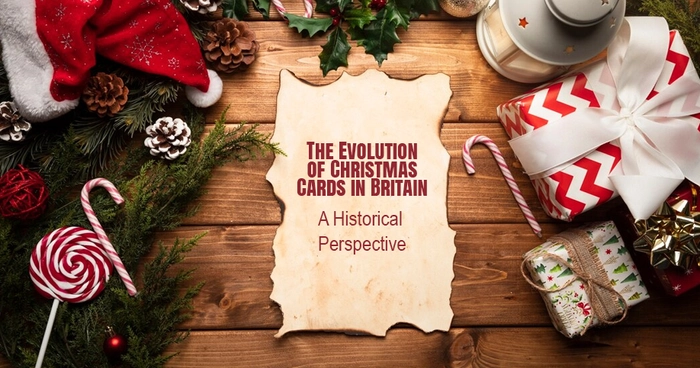Christmas is a time of joy, celebration, and sharing goodwill. One of the most charming traditions during this festive season is the exchange of Christmas cards. This custom has evolved over time, reflecting changes in society, technology, and art. Let’s take a journey through the history of Christmas cards in Britain and see how they have transformed over the years.
The Birth of the Christmas Card
The tradition of sending Christmas cards began in Britain in the 19th century. The first known Christmas card was created in 1843 by Sir Henry Cole, a civil servant and founder of the Victoria and Albert Museum. Cole was looking for a way to encourage people to use the new postal services. He commissioned his artist friend, John Callcott Horsley, to design a card that could be sent to friends and family.
Horsley designed a triptych card, which had three panels. The centre panel depicted a family enjoying a festive meal, while the side panels showed scenes of charity, with people giving food and clothing to the poor. The card bore the simple message: "A Merry Christmas and a Happy New Year to You." This first Christmas card was sold for a shilling each, making it accessible only to the wealthier classes.
The Popularisation of Christmas Cards
The idea of sending Christmas cards quickly caught on. By the 1860s, advances in printing technology and the reduction in postal rates made Christmas cards more affordable and popular among the general public. The introduction of the halfpenny postage rate in 1870 significantly boosted the tradition, as it became cheaper to send cards across the country.
Early Christmas cards often featured images of the nativity, holly, robins, and snowy landscapes. They were typically quite formal, reflecting the Victorian era’s values and aesthetic sensibilities. By the late 19th century, humorous and whimsical designs also became popular, showing that the tradition was evolving to include a broader range of themes and styles.
The Golden Age of Christmas Cards
The period from the late 19th century to the early 20th century is often referred to as the golden age of Christmas cards. During this time, the quality of card design and production reached new heights. Advances in chromolithography, a method of printing in multiple colours, allowed for vibrant and detailed images. Artists like Kate Greenaway and Walter Crane became famous for their beautiful and imaginative card designs.
Christmas cards from this era often featured elaborate and intricate artwork. Scenes of festive merriment, Victorian homes adorned with decorations, and picturesque winter landscapes were common themes. Cards also started to include embossed and textured elements, making them more tactile and visually appealing.
The Impact of World Wars
The two World Wars had a significant impact on the production and themes of Christmas cards. During World War I, many cards featured patriotic themes, with images of soldiers, flags, and messages of hope and support for the troops. Cards often depicted families awaiting the return of their loved ones, reflecting the sentiments of a nation at war.
World War II brought about a more sombre and restrained approach to Christmas cards. Due to paper rationing, cards were smaller and less elaborate. However, the spirit of Christmas and the tradition of sending cards persisted, with designs often focusing on themes of peace, resilience, and hope for the future.
Post-War to Modern Times
After World War II, Christmas cards became more commercialised and widely available. The rise of mass production and improvements in printing technology made cards cheaper and more diverse in their designs. The 1950s and 1960s saw a boom in the variety of Christmas cards available, with designs ranging from traditional nativity scenes to modern, abstract patterns.
The 1970s and 1980s saw a trend towards personalised and customised cards. People began to include family photographs and personal messages, making the cards more intimate and unique. The advent of digital photography and printing further revolutionised this trend, allowing for high-quality personalised cards to be produced easily and affordably.
The Digital Age
The digital age has brought about significant changes in the way Christmas greetings are shared. E-cards and digital greetings have become popular alternatives to traditional paper cards. They are environmentally friendly, instantaneous, and often free, making them an attractive option for many.
However, despite the convenience of digital cards, traditional paper Christmas cards have not disappeared. Many people still cherish the tangible nature of a physical card. Receiving a card in the post can feel more personal and thoughtful compared to a digital message. Additionally, the act of choosing, writing, and sending a card is a cherished ritual for many, adding to the festive experience.
The Future of Christmas Cards
The future of Christmas cards is likely to see a blend of tradition and innovation. While digital cards will continue to grow in popularity, there is also a strong sentiment towards preserving the tradition of sending physical cards. Eco-friendly options, such as cards made from recycled materials or those that can be planted to grow into trees, are becoming increasingly popular.
Moreover, technology is enhancing the traditional card-sending experience. Augmented reality (AR) and QR codes are being integrated into cards, allowing recipients to access multimedia content, such as videos and animations, adding a modern twist to the tradition.
What Do You Prefer?
Choosing between traditional and digital Christmas cards comes down to personal preference and circumstances. Here’s a quick look at the benefits of each to help you decide what suits you best:
Traditional Christmas Cards
Personal Touch: A physical card can feel more personal and thoughtful. The effort of selecting, writing, and sending a card shows you care.
Tangible Keepsakes: Traditional cards can be kept and cherished. Many people enjoy displaying cards in their homes during the festive season.
Art and Aesthetics: Physical cards often feature beautiful artwork, textures, and designs that can be appreciated in a way that digital images can’t replicate. To enhance the aesthetic appeal of the Christmas card more, you can use Christmas Stamps.
Supporting Small Businesses: Buying traditional cards often supports local artists and small businesses that create and sell these products.
Digital Christmas Cards
Eco-Friendly: Digital cards are environmentally friendly, as they don’t require paper, printing, or transportation.
Convenience: They can be sent instantly, which is perfect for last-minute greetings or for reaching loved ones who live far away.
Cost-Effective: Many digital cards are free or cheaper than traditional cards, which can help reduce holiday expenses.
Creative Possibilities: Digital cards can include multimedia elements such as animations, videos, and music, making them interactive and engaging.
No Postal Delays: Digital cards avoid the risk of postal delays, ensuring your greetings arrive on time, even during busy holiday seasons.
Ultimately, the choice between traditional and digital Christmas cards is up to you. You might even decide to use a combination of both, sending physical cards to some and digital greetings to others, depending on your relationships and circumstances. No matter what you choose, the most important thing is the thought and love you put into your holiday greetings, spreading joy and warmth to those you care about.
Takeaway
The evolution of Christmas cards in Britain is a fascinating journey that reflects broader societal changes. From the first card designed by Sir Henry Cole in 1843 to the modern-day blend of traditional and digital greetings, Christmas cards have remained a beloved part of the festive season. They capture the spirit of Christmas, offering a way to connect with loved ones, share goodwill, and celebrate the joy of the season. As we look to the future, it is clear that while the ways in which we send Christmas greetings may continue to evolve, the tradition of exchanging cards will endure, bringing joy and warmth to countless people each year.


